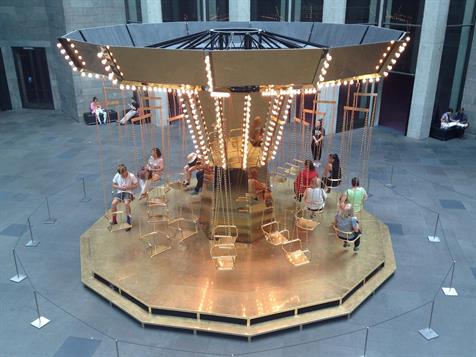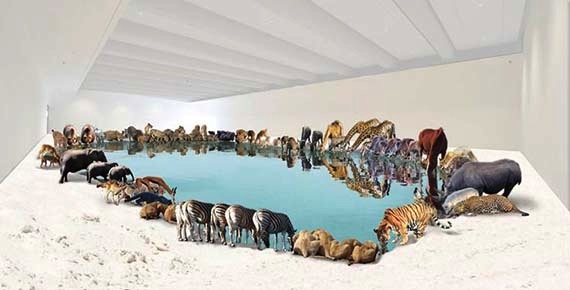David Shrigley: Life and Life Drawing. Did it really do as well as the figures suggest?
Last month The Art Newspaper released its annual 2015 Visitor Figures report for art galleries and museums globally.
While Australia has consistently made it in to the top 50 for annual attendance, the shock surprise for 2015 was that Australian ranked Number 1 globally with the most attended contemporary art exhibition.
Read: Australians rank well in international visitor report
The National Gallery of Victoria’s (NGV) exhibition David Shrigley: Life and Life Drawing, with 5,602 visitors daily, trumped Robert Gober at the Museum of Modern Art in New York and Jeff Koons’ Retrospective at both Guggenheim Bilboa and Centre Pompidou – where it was the most visited exhibition in Paris for the year.
The first Australian survey of the Glaswegian artist also ranked ahead of superstars exhibitions on David Bowie, Bjork, Yoko Ono, and Ai Weiwei at major international venues.
One that surprised us, was that Shrigley sat in the overall list ahead of the opening exhibition for the new Whitney Museum of American Art (New York), which celebrated its own with America is Hard to See (5,352 daily or 748,554 total) and, in a bizarre twist of numbers, also sat behind NGVs theme-based show, The Horse (5,358 visitors daily or 427,108).
We might be curious why an exhibition by the quirky cultish artist from Glasgow did so well in Australia?
One might put it down to one of those freak “oh wow” moments that struck a chord with local audiences, but the fact that three of the top ten contemporary exhibitions internationally were presented by NGV International – plus six exhibitions holding rank in the top 50 shows overall (no other Australian gallery made it) – raises a few alarms.
Is there a problem in how Australia is recording or interpreting visitor numbers?
What are we measuring?
While every attempt is made at transparency – and there is no suggestion of wrong play here – the system would appear to be flawed.
Is it appropriate to pit a foyer exhibition of a single artwork against a major survey exhibition, such as Carlos Amorales suite of mobile sculptures at the NGV that was ranked almost on par with the Whitney’s inaugural show of more than six hundred artworks and a serious look at the history of a nation and an institution.

Carsten Holler at NGV; Photo ArtsHub
Amorales’s installation or Carsten Holler’s Golden Mirror Carousel (pictured above) – both foyer works at NGV International – would have been viewed incidentally by all who entered the gallery, and were counted.
It is quite a different situation to a viewer specifically visiting the gallery to see a particular exhibition – an argument that is escalated when it is a ticketed show.
What the numbers don’t reveal is the piggy-back opportunity that timing can also create. For example, a collection show might record blistering success because it is staged alongside a highly-promoted shipped-in blockbuster.
The NGV Collection show Exquisite Threads: English Embroidery made it into the top 50 exhibitions attended internationally (ranked 45 with 4,479 daily average or 383,247) arguably because it was presented alongside the blockbuster Medieval Moderns: the Pre-Raphaelites at NGV International (ranked 46 with 4,455 per day or 351,308).
The same argument could be made for Holler’s carousel presented in NGV’s Federation Court while The Fashion World of Jean Paul Gautier drew record crowds for the gallery.
The biggest flaw in published attendance or program statistics for a calendar year is that they don’t show the spread of high-budget and high-resourced shows across the years and the downtimes in programming.
A good example during this review period is Queensland Art Gallery (QAGOMA), which was focused on the 8th Asia Pacific Triennial, including the commissioning of new work – 70% of the show entered the collection with the exhibition’s closure this month.
The year also came off the back of a high-cost high-production exhibition the year prior with Cai Guo-Qiang’s Heritage (2013) at GOMA.
Director QAGOMA, Chris Saines told ArtsHub in an earlier interview: ‘I have worked in institutions like this for a very long time and one thing I know is that attendance does not just exponentially increase year-on-year, decade-on-decade, at no institution in the world, and when you are repositioning and reframing what you do around a new strategic plan it takes a bit of gear changing.’
The figures don’t say everything; you have to look at the conditions around the numbers, and ride the records over the low periods.

Supplied QAGOMA
Saines continued: ‘There is no doubt with Cai (Guo-Qiang’s exhibition Heritage in 2013, pictured above), we achieved a spike that year – we went up to 1.32 million (visitors) …but in the year just gone (2014), to the same extent it came up it’s gone down.’
Read: Star gazing: looking beyond Queensland
This is also a problem faced in the performing arts where, at the beginning of each season launch questions of gender, new work, commissioned writers etc. are tallied up with such scrutiny that the numbers can blinker the bigger picture.
We are not privy to what is in the production stage that might over-whelming balance the lows.
Like any strategic plan that addresses visions and key performance indicators, perhaps the reporting of annual attendance and program accounting should be placed in perspective of three-year cycle.
The new economics of measuring return
The culture of accountability has been drummed into arts and cultural organisations, particularly as funding has become tighter. We need to work ever harder to prove that we are worthy of those dollars.
But the numbers fail to measure experience or long term effects.‘I am more interested in the way that what we do adds to our reputation in the world and for our audience. They are the things that drive us not “can we hit the peaks, can we hit the peaks”,’ Saines told ArtsHub.
Measuring the experience has also become the new matrix in corporate partnerships – what we used to term sponsorship.
Fady Taouk, General Manager Loyalty and Partnerships for Telstra said at a recent panel discussion on corporate giving: ‘You need to think about why you sponsor things and have that as your KPI. We talk about “experiences redeemed”.
Read: Why bother with corporate sponsorship?
Andy Wright, Co-Founder of the consultancy firm For the People, added: ‘There is a kind of trend away from financial accountable or return, but we just can’t move away from ROI (Return On Investment) accounting completely.’
Emma Giammarco, Senior Marketing Manager Macquarie Centre and AMP Capital Shopping Centres added to the discussion: ‘It always come down to the dollar, but the way we measure the ROI is more about engagement – the more engaged our consumers are the more likely they will come into the Centre and spend. It is about place making.’
Giammarco speaks of creating real experiences in the corporate partnership landscape, and while numbers help they are not exclusive to decision making. It is a philosophy that Wesfarmers Arts has been adopting since the 1970s.
Helen Carroll, Manager of the company’s collection and arts programming said: ‘ROI is a term I never actually use. For us it is more about being associated with quality and innovation and artistic integrity.’
With the announcement of the Australian Bureau of Statistics (ABS) in September 2014 that is would no longer collect cultural data, organisations have had to be more hands-on in creating their own data.
It is our responsibility as an arts sector to demonstrate value where value is created. We need to become more savvy
Improving reporting of visitor numbers
1. When possible, count visitors by entrance to an individual exhibition, not according to total gallery attendance the exhibition running period
2. Calculate attendance as a per day average, which takes into account that some exhibitions run for considerably longer than others.
The Art Newspaper’s ranks exhibitions by a daily attendance rather than an overall total. In Australia we tend to celebrate the record total. Greater transparency and a more accurate comparative picture across exhibitions and institutions would be achieved if our organisations were to adopt the daily attendance system.
3. Start to capture other data – the bigger picture of the experience is more valuable than a tally of “bums on seats”
Next week NGVs attendance figures will come in for its Andy Warhol / Ai Weiwei blockbuster, joining recent announcements by NGA, QAGOMA, AGNSW with record attendance.
We will put the numbers under scrutiny, and endeavor to bring you the story between the lines of those impressive totals.





